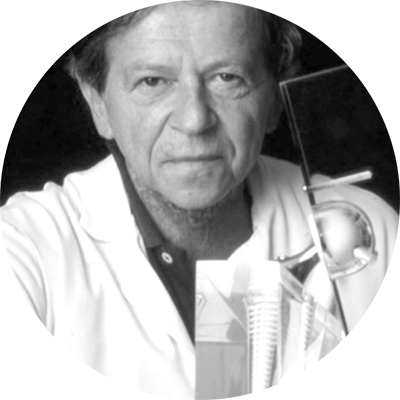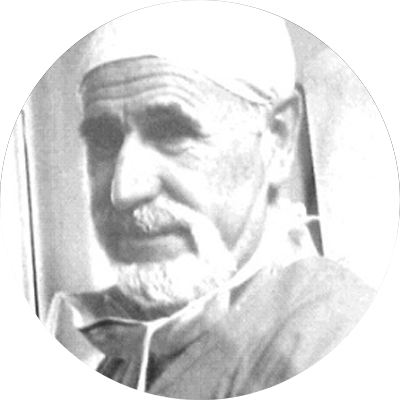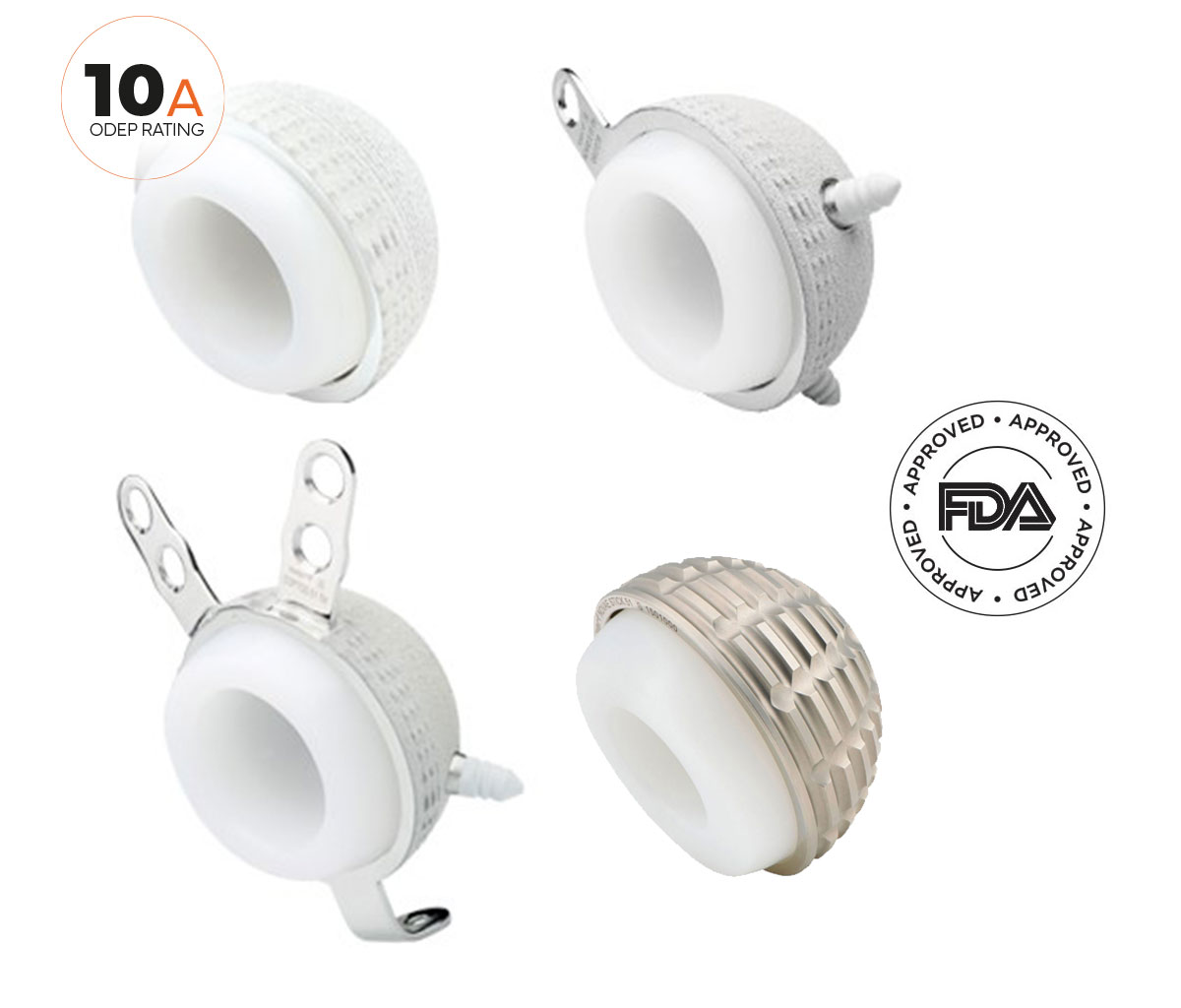della
SERF
Inventore
DOPPIA
MOBILITÀ
Il CONCETTO
di Doppia Mobilità inventato nel 1975 dal Prof. Gilles BOUSQUET dell’Ospedale Universitario di Saint – Etienne e da André RAMBERT, fondatore di SERF, si basa su due principi fondamentali in ortopedia.
L’idea
La prima mobilità
La prima mobilità permette la mobilità tra un inserto e una testa femorale secondo il concetto Charnley: una testa di piccolo diametro per ridurre il volume di usura e uno spessore massiccio di polietilene.
La seconda mobilità
La seconda mobilità è l’elevata mobilità tra inserto e cotile acetabolare. È vicina al vero diametro della testa femorale.
Si basa sul concetto di McKee-Farrar di usare una testa di grande diametro per aumentare l’ampiezza dell’articolazione e ridurre allo stesso tempo il rischio di lussazione. In questo modo si riduce il rischio di instabilità.
Un’ invenzione
Francese
Negli anni ’70 del secolo scorso, l’incidenza della recidiva dopo un primo episodio di lussazione ridotta variava tra il 25 e il 60%, a seconda della serie.
Per questo nel 1975, Signore André RAMBERT (fondatore di SERF) e il Prof. Gilles BOUSQUET (capo dipartimento dell’ospedale universitario di Saint-Etienne) hanno unito le loro competenze per sviluppare il concetto di doppia mobilità, che oggi gode di più di 45 anni di esperienza.

Prof. Gilles BOUSQUET
(1936 – 1996)

Signore André RAMBERT
(1927 – 2018)
1975
Concetto iniziale
1977
Cotile originale a doppia mobilità
cementato
1979
Novae-1
Sviluppo del concetto a tre perni
Rivestimento in allumina
1998
Novae® E
Tre perni
Design modificato :
Emisfero + cilindro di 3mm
Rivestimento :
Allumina + HA
1999
CI E
Evoluzione con la creazione di uno smusso
2000
Novae® Sunfit
Nuovo cotile:
Press-fit équatoriale e macrostruttura a speroni
Rivestimento invariato
2002
Novae® Stick
Fissaggio cementato e macrostruttura a rete
2003
Novae® Coptos
Adatto per revisioni importanti
Fissaggio con 2 linguette, 2 perni e gancio
Rivestimento invariato
2003
Novae® K
Telaio di supporto anatomico fedele al design originale
2004
Novae® Stick
Evoluzione delle macrostrutture
2007
Novae® Sunfit TH
Evoluzione delle macrostrutture
Aggiunta di un doppio rivestimento Ti + HA
2009
Novae® E TH
Evoluzione delle macrostrutture
Aggiunta di un doppio rivestimento Ti + HA
2009
Novae® Coptos TH
Evoluzione delle macrostrutture
Aggiunta di un doppio rivestimento Ti + HA
2011
Novae® KE
Oggi SERF è l’unica azienda con una tradizione così solida sulla Doppia Mobilità,
con oltre 45 anni di ottimizzazioni ed esperienza.

Per maggiori informazioni sulla nostra gamma di cotili a doppia mobilità, visitare la pagina dedicata.
Ne parlano
Tra gli 80 articoli disponibili sul nostro cotile acetabolare a doppia mobilità, abbiamo selezionato più di 38 articoli che evidenziano l’interesse e l’affidabilità del nostro concetto e le ottimizzazioni sviluppate sulla doppia mobilità.
- Adam P, Farizon F, Fessy M-H. [Dual articulation retentive acetabular liners and wear : surface analysis of 40 retrieved polyethylene implants].
Rev Chir Orthop Reparatrice Appar Mot. nov 2005;91(7):627 36. - Adam P. Contribution à l’étude des arthroplasties totales de hanche à double mobilité. Analyse clinique et mécanique. Confrontation des données expérimentales à l’étude des pièces ayant fonctionné in vivo [Internet].
2006. Disponible sur : http://www.theses.fr/2006EMSE0014/document - Bel J-C, Carret J-P. Total hip arthroplasty with minimal invasive surgery in elderly patients with neck of femur fractures: our institutional experience. Injury.
janv 2015;46 Suppl 1:S13-17. - Bouvier J. Etude à court terme des prothèses totales de hanche sans ciment. Cotyle NOVAE-Tige SAGITTA.
Travail du Service d’Orthopédie Traumatologie du Centre Hospitalier d’Aubenas (07200). 1997. - Boyer B. Modélisation du fonctionnement de la Prothèse Totale de Hanche Double Mobilité – Compréhension des comportements biomécanique et tribologique.
[Internet]. 2014. Disponible sur: http://www.theses.fr/2014EMSE0762/document - Boyer B, Neri T, Di Iorio A, Geringer J, Philippot R, Farizon F. The linear penetration rate is not relevant for evaluating wear of dual mobility cups: an explant study.
Int Orthop. mars 2017;41(3):599 603. - Boyer B, Neri T, Geringer J, Di Iorio A, Philippot R, Farizon F. Understanding wear in dual mobility total hip replacement: first generation explant wear patterns.
Int Orthop. mars 2017;41(3):529 33. - Boyer B, Philippot R, Geringer J, Farizon F. Primary total hip arthroplasty with dual mobility socket to prevent dislocation: a 22-year follow-up of 240 hips.
Int Orthop. mars 2012;36(3):511 8. - CIRILLI A. Reconstruction osseuse apres descellement de protheses totales de hanche cimentees : a propos de 46 cas de reprise par prothese sans ciment de bousquet.
1989. - Dangin A, Boulat S, Farizon F, Philippot R. Prevention of Dislocation Risk During Hip Revision Surgery with the Dual Mobility Concept; Study of a New Generation of Dual Mobility Cups.
Surg Technol Int. 26 oct 2016;29:314 9. - Delaunay CP, Bonnomet F, Clavert P, Laffargue P, Migaud H. THA using metal-on-metal articulation in active patients younger than 50 years.
Clin Orthop Relat Res. févr 2008;466(2):340 6. - El Blidi S. Le traitement des luxations récidivantes de prothèses totales de hanche par le cotyle rétentif de Bousquet.
[Université de Caen]; 1992. - F. Lemonne, P. Bizot, R. Nizard, E. Van Gaver, G.-F. Penneçot, L. Sedel. Traitement chirurgical d’une agénésie fémorale sévère chez l’adulte.
Revue de Chirurgie Orthopédique et Traumatologique. nov 2003;1304(7):580. - Farizon F, de Lavison R, Azoulai JJ, Bousquet G. Results with a cementless alumina-coated cup with dual mobility. A twelve-year follow-up study.
Int Orthop. 1998;22(4):219 24. - Fessy M-H. La double mobilité.
Revue de Chirurgie Orthopédique et Traumatologique. nov 2010;96(7):891 8. - Fessy M-H. Dual Mobility Concept – Bipolar Hip Replacement. In: Bentley G, éditeur.
European Surgical Orthopaedics and Traumatology: The EFORT Textbook [Internet]. Berlin, Heidelberg: Springer Berlin Heidelberg; 2014. p. 2635‑47. Disponible sur:
https://doi.org/10.1007/978-3-642-34746-7_113 - Fessy M-H. La double mobilité. Un concept stéphanois.
Maitrise orthopédique. 2006. - Kleeman L, Lachiewicz P. Dual-mobility components obviate the need for constrained components in revision total hip arthroplasty–Affirms.
Seminars in Arthroplasty. 1 déc 2016;27(4):256 60. - Mohammed R, Hayward K, Mulay S, Bindi F, Wallace M. Outcomes of dual-mobility acetabular cup for instability in primary and revision total hip arthroplasty.
J Orthop Traumatol. mars 2015;16(1):913. - Neri T, Boyer B, Batailler C, Klasan A, Lustig S, Philippot R, et al. Dual mobility cups for total hip arthroplasty: tips and tricks.
SICOT J. 2020;6:17.
- Philippot R, Camilleri JP, Boyer B, Adam P, Farizon F. The use of a dual-articulation acetabular cup system to prevent dislocation after primary total hip arthroplasty: analysis of 384 cases at a mean follow-up of 15 years.
Int Orthop. août 2009;33(4):927 32. - Philippot R, Boyer B, Farizon F. Intraprosthetic dislocation: a specific complication of the dual-mobility system.
Clin Orthop Relat Res. mars 2013;471(3):965 70. - KOHLMANN R. L’implant cotyloïdien sans ciment « NOVAE T » à crochet obturateur dans les descellements aseptiques et les dysplasies luxantes. Revue des 28 cas opérés au pavillion T. Hopital E.Herriot. LYON. [Lyon]; 1998.
- Lecuire F, Benareau I, Rubini J, Basso M. [Intra-prosthetic dislocation of the Bousquet dual mobility socket].
Rev Chir Orthop Reparatrice Appar Mot. mai 2004;90(3):249 55. - Leiber- Wackenheim F. Reprise acétabulaire par cupule à double mobilité pour luxation recidivante de PTH. A propos de 59 cas à 8 ans de recul.
[Université de Picardie Jules Verne Faculté de médecine d’Amiens]; 2007. - Leiber-Wackenheim F, Brunschweiler B, Ehlinger M, Gabrion A, Mertl P. Treatment of recurrent THR dislocation using of a cementless dual-mobility cup: a 59 cases series with a mean 8 years’ follow-up.
Orthop Traumatol Surg Res. févr 2011;97(1):8 13. - Martino ID. Dual mobility cups in total hip arthroplasty.
WJO. 2014;5(3):180. - Mesko DR, Molloy R, Rueda CH. The dual mobility liner: Is it ready for prime time?
Seminars in Arthroplasty. 1 sept 2015;26(3):186 9. - Neri T, Boyer B, Geringer J, Di Iorio A, Caton JH, PhiIippot R, et al. Intraprosthetic dislocation of dual mobility total hip arthroplasty: still occurring?
Int Orthop. mai 2019;43(5):1097 105. - Neri T, Philippot R, Farizon F, Boyer B. Results of primary total hip replacement with first generation Bousquet dual mobility socket with more than twenty five years follow up. About a series of two hundred and twelve hips.
Int Orthop. mars 2017;41(3):557 61. - Neri T, Philippot R, Klasan A, Putnis S, Leie M, Boyer B, et al. Dual mobility acetabular cups for total hip arthroplasty: advantages and drawbacks.
Expert Rev Med Devices. nov 2018;15(11):835 45. - Philippot R, Adam P, Farizon F, Fessy M-H, Bousquet G. Survie à dix ans d’une cupule double mobilité non cimentée.
Revue de Chirurgie Orthopédique et Réparatrice de l’Appareil Moteur. 1 juin 2006;92(4):326 31. - Vielpeau C, Lebel B, Ardouin L, Burdin G, Lautridou C. The dual mobility socket concept: experience with 668 cases.
Int Orthop. févr 2011;35(2):225 30. - Leclercq S, El Blidi S, Aubriot JH. Traitement de la luxation récidivante de prothèse totale de hanche par le cotyle de Bousquet. A propos de 13 cas.
Revue De Chirurgie Orthopedique Et Reparatrice De L’appareil Moteur. 1995;1995, 81, 389 394. - Philippot R, Baulot E, Vermorel P-H, Genestoux V, Alixant P, Martz P, et al. Outcomes of Augmented Dual Mobility Acetabular Cups.
Surg Technol Int. 10 nov 2019;35:274 9. - Philippot R, Neri T, Boyer B, Viard B, Farizon F. Bousquet dual mobility socket for patient under fifty years old. More than twenty year follow-up of one hundred and thirty one hips.
Int Orthop. mars 2017;41(3):589 94. - Pineau V, Lebel B, Gouzy S, Dutheil J-J, Vielpeau C. Dual mobility hip arthroplasty wear measurement: Experimental accuracy assessment using radiostereometric analysis (RSA).
Orthop Traumatol Surg Res. oct 2010;96(6):609 15. - Wegrzyn J, Malatray M, Al-Qahtani T, Pibarot V, Confavreux C, Freyer G. Total Hip Arthroplasty for Periacetabular Metastatic Disease. An Original Technique of Reconstruction According to the Harrington Classification.
J Arthroplasty. août 2018;33(8):2546 55.